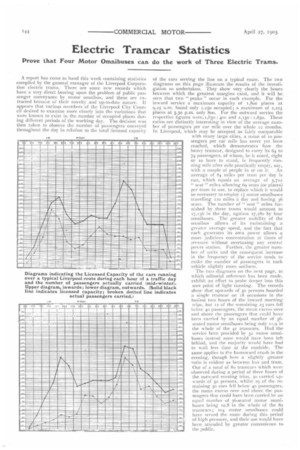Electric Tramcar Statistics
Page 8

If you've noticed an error in this article please click here to report it so we can fix it.
Prove that Four Motor Omnibuses can do the work of Three Electric Trams.
A report has come to hand this week containing statistics compiled by the general manager of the Liverpool Corporation electric trams. There are some new records which have a very direct bearing upon the problem of public passenger conveyance by motor omnibus, and these are extracted because of their novelty and up-to-date nature. ft appears that various members of the Liverpool City Council desired to examine more closely into the variations that were known to exist in the number of occupied places during different periods of the working day. The decision was then taken to observe the number of passengers conveyed throughout the day in relation to the total licensed capacity
of the cars serving the line on a typical route_ The two diagrams on this page illustrate the results of the investigation so undertaken. They show very clearly the hours between which the greatest margins exist, and it will be seen that two " peaks " occur in each example. For the inward service a maximum capacity of 1,800 places at 9.25 a.nl. found only 1,250 occupied; a maximum of 2,225 places at 5.30 p.m. only Soo. For the outward service the respective figures were,i,S5o : 400 and 2,150 1,850. These ratios are distinctly interesting in view of the average number of passengers per car mile over the whole 12 months. In Liverpool, which may be accepted as fairly comparable with many large cities, a mean of in passengers per car mile has never yet been reached, which demonstrates how the heavy tramcar, designed to carry its 64 to 74 passengers, of whom, be it noted, eight or to have to stand, is frequently running mile after mile practically empty, say,
ME9 EMS Ell PM ES
with a couple of people in or on it. An average of 84 miles per tram per day is run, which equals an average of 5,712 " seat miles allowing 69 seats (or places) per tram in use, to replace which it would be necessary to employ IA motor omnibuses travelling 120 miles a day and having 36 seats. The number of " seat " miles furnished by three trains would amount to 17,136 in the day, against 17,280 by four omnibuses. The greater mobility of the omnibus allows of its maintaining a greater average speed, and the fact that each generates its own power allows a more judicious concentration at times of pressure without overtaxing any central power station. Further, the greater number of units and the consequent increase in the frequency of the service tends to make the number of passengers in each vehicle slightly more on The two diagrams on the next page, to which editorial reference has been made, exhibit an effort to probe deeper into this sore point of light running. The records show that upwards of 5n persons boarded a single tramcar on i8 occasions in the busiest two hours of the inward morning trips, hut 72 of the remaining 23 cars felt below 40 passengers, the mean excess over and above the passengers that could have been carried by an equal number of 36seated motor omnibuses being only 11.9 iO the whole of the 41 tramcars. Had the service been provided by 5i. motor omnibuses instead none would have been left behind, and the majority would have had to wait less time at the roadside. The same applies to ttee homeward crush in the evening, though here a slightly greater ratio is evident as between bus and train. Out of a total of So tramcars which were observed during a period of three hours of the outward evening trips, 30 carried npwards of 5o persons, whilst 29 of the remaining 5o cars fell below 40 passengers, the mean excess over and above the passengers that could have been carried by an equal number of 16-seated motor omnibuses being TO.8 in the whole of the So tramcars ; 104 motor omnibuses could have served the route during this period of high pressure, and their use would havebeen .attended by greater convenience to the public.




















